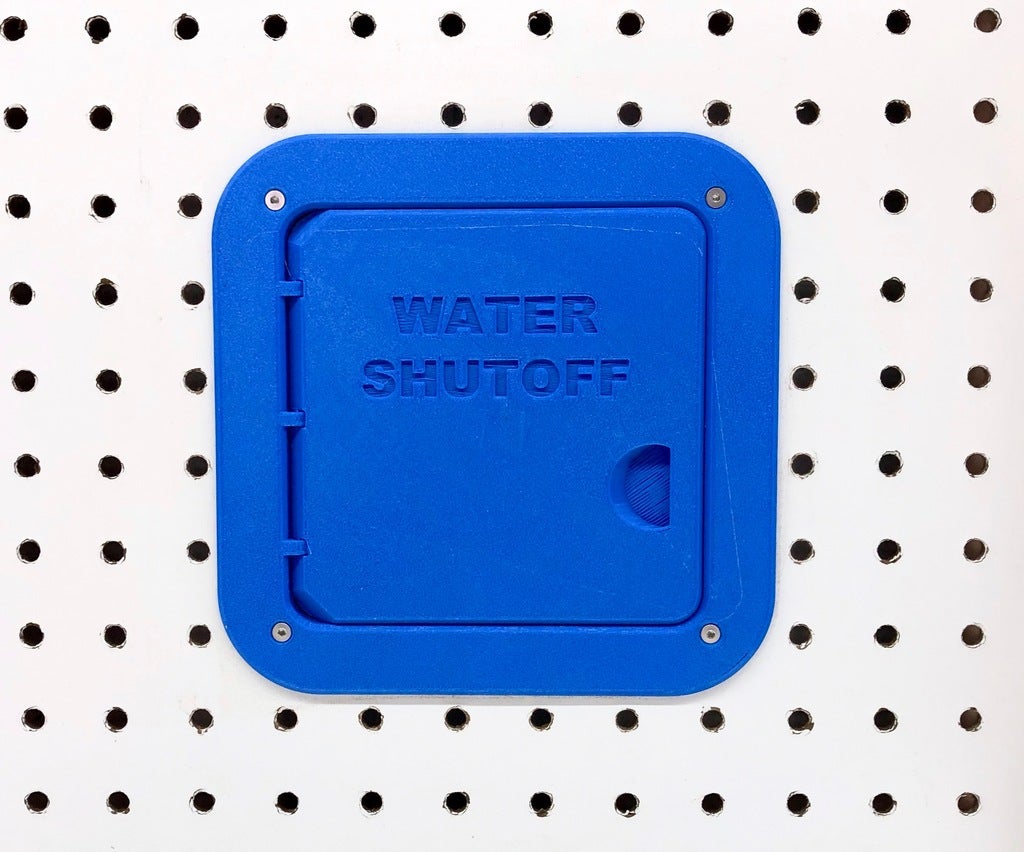
Print-in-place pegboard access door
prusaprinters
<p>I'm building a work bench in my basement, and need access through the pegboard to the water shutoff valve and an outlet box. Rather than just sawing an ugly hole, I thought I'd model up a quick set of labeled doors!</p> <p>These are parametrically modeled based on the hole size and spacing of the pegboard, along with the number of hole rows and columns of the desired cutout. There are a few parametric steps that aren't<em>perfect</em>, and there was a little tweaking necessary after switching the number of rows, so I've included F3D files for both the 5x6 and 6x6 patterns to get you started.</p> <p>To install, simply use a keyhole or jigsaw to cut a hole in the pegboard, through the existing peg holes, of the desired size. Use M3 countersunk screws to sandwich the pegboard between the door assembly and the back plate. Optionally, there are holes for friction-fit 6x3mm neodymium magnets to keep the door securely latched.</p> <h3>Print instructions</h3><h3>Category: Organization Summary</h3> <p>I'm building a work bench in my basement, and need access through the pegboard to the water shutoff valve and an outlet box. Rather than just sawing an ugly hole, I thought I'd model up a quick set of labeled doors!</p> <p>These are parametrically modeled based on the hole size and spacing of the pegboard, along with the number of hole rows and columns of the desired cutout. There are a few parametric steps that aren't<em>perfect</em>, and there was a little tweaking necessary after switching the number of rows, so I've included F3D files for both the 5x6 and 6x6 patterns to get you started.</p> <p>To install, simply use a keyhole or jigsaw to cut a hole in the pegboard, through the existing peg holes, of the desired size. Use M3 countersunk screws to sandwich the pegboard between the door assembly and the back plate. Optionally, there are holes for friction-fit 6x3mm neodymium magnets to keep the door securely latched.</p> <h3> Print Settings</h3> <p><strong>Printer:</strong></p> <p>Artillery3D Genius</p> <p><p class="detail-setting rafts"><strong>Rafts: </strong> <div><p>No</p></div><strong>Supports:</strong></div></p> <p>No</p> <p><p class="detail-setting resolution"><strong>Resolution: </strong> <div><p>0.2mm</p></div><strong>Infill:</strong></div></p> <p>15%</p> <p><strong>Filament:</strong> 3D Solutech PLA Blue <br/> <p class="detail-setting notes"><strong>Notes: </strong> </p><div><p>Position the door assembly <em>face-down</em> on the build surface, and you won't need any supports. I used 3 bottom/4 top layers, but could have used another bottom layer for the white PLA to hide the infill. :) </p> Modeled with 0.5 mm clearance for the print-in-place hinge assembly, and that has worked great on my printer. There is a parameter in the F3D file if you need to increase or decrease that clearance.</div></p></p></p>
With this file you will be able to print Print-in-place pegboard access door with your 3D printer. Click on the button and save the file on your computer to work, edit or customize your design. You can also find more 3D designs for printers on Print-in-place pegboard access door.
